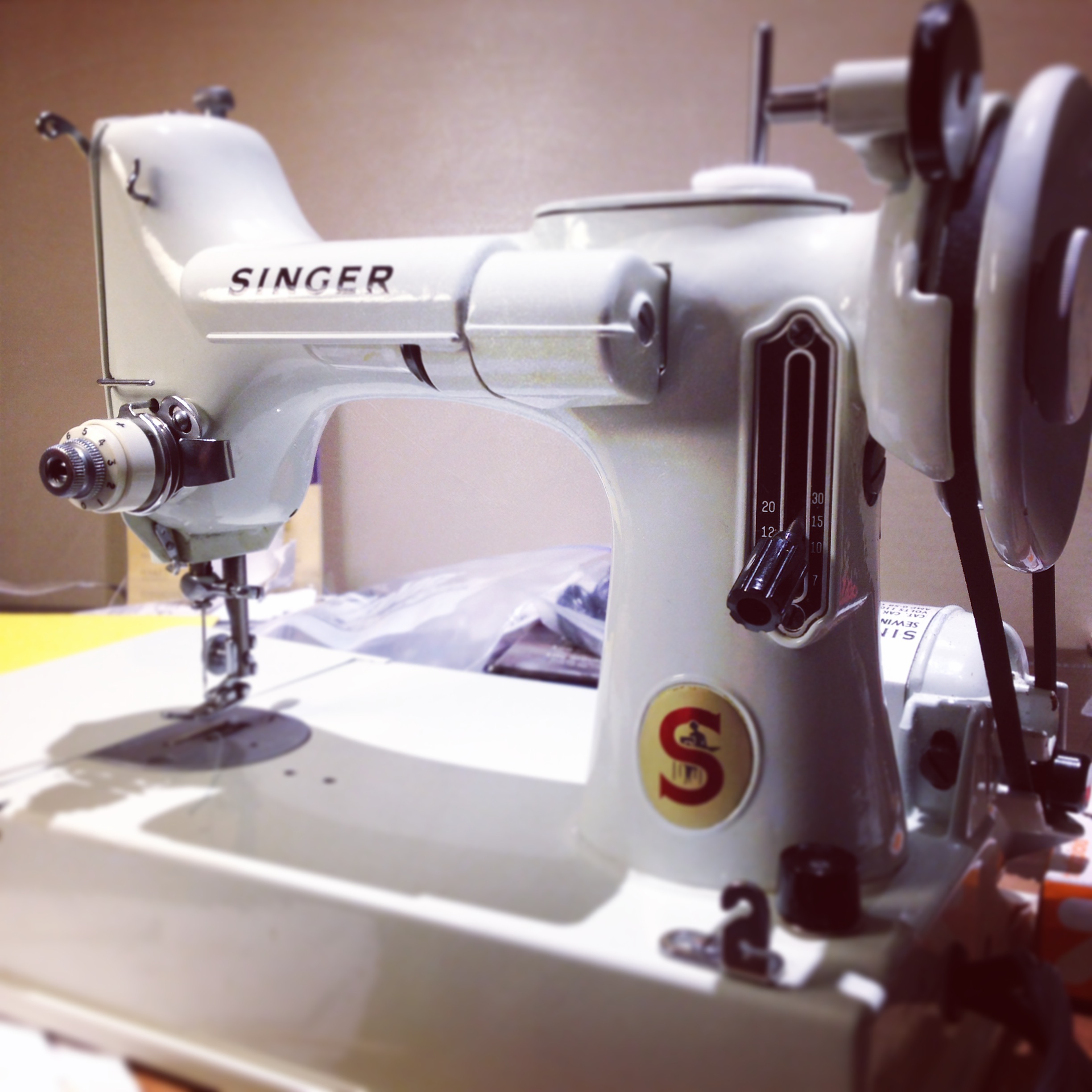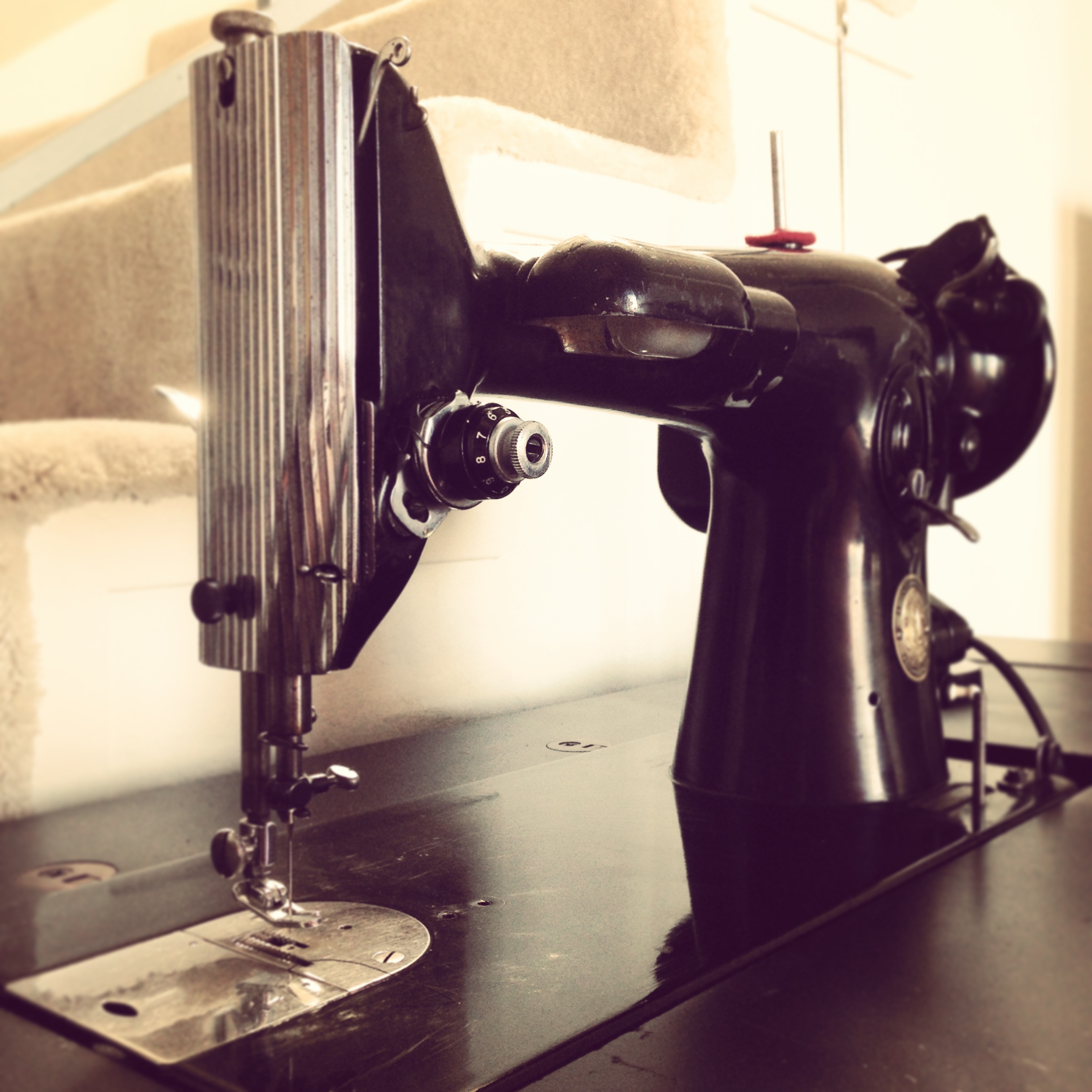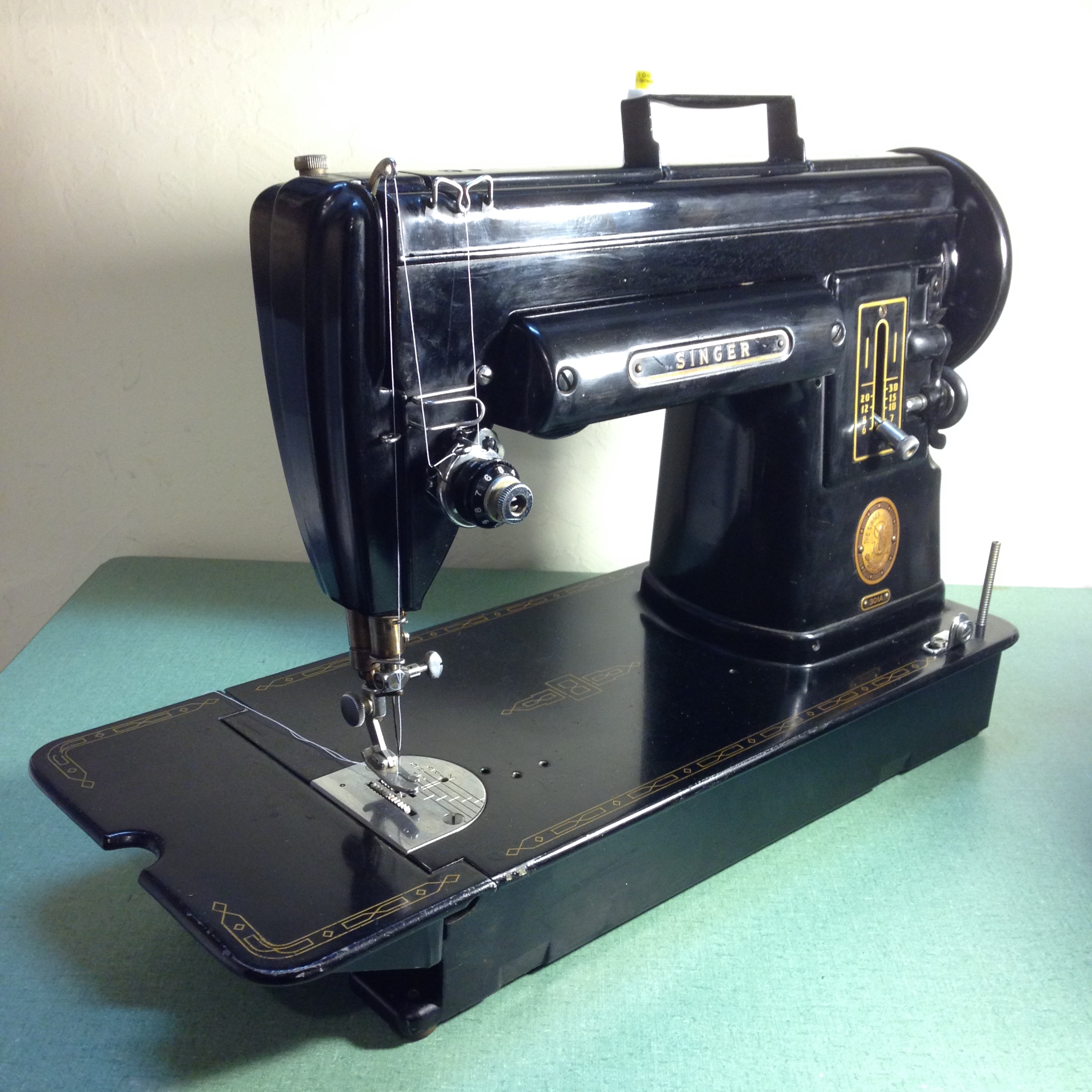
This is the Singer Featherweight 221k. The white version of the ever popular 221. It sports a shorter bed than its black counterparts and is belt driven, rather than gear driven.
Read the review here.

Produced in the early 60s, the retro space aged 500a is also known as the Singer Rocketeer. This is a fully gear driven, top loading, cam accepting, rotary hook machine that represented the pinnacle of Singer's development--marrying both top notch build quality with a rich set of features. Later machines suffered from a number of cost cutting measures in an effort to compete with the increasing number of Japanese machines flooding the market.
Read the review here.

Single needle, 6mm zigzag, lock-stitch industrial machine. Favored by sail makers and often considered an artisan machine due to its zigzag capability. The 138-6/21 BS version has a wide 6mm stitch width. One of the smoothest machines I've had the pleasure to sew with.
Read the review here.

This is 3/4 portable Kenmore. It is a fully featured machine capable of straight stitch, zigzag, automatic buttonholes and a variety of utility stitches.
Read the review here.

The Bernina 730 Record is one of my favorite Berninas. A direct descendant of the 530 Record and predecessor to the best selling 830, this oscillating hook machine boasts an impressive 20 built in stitches via an internal cam stack.
Read the review here.

Very popular with quilters, this half size Singer has defined portable among sewing machines. Despite its minimal size, this aluminum rotary hook machine is every bit as capable as its larger cast iron brethren.
Read the review here.

Check out this beauty! A Singer Model 20 toy chain stitch machine with an electric motor attached!

This is an early Singer Model 20 toy sewing machine. It's a cast iron hand cranked chain stitcher.

This is a Singer 99k. It's a cast iron 3/4 sized flat bed portable machine. This is one of the later models and has the ability to reverse. This belt-driven beauty runs smooth and quiet, hovering around 1000 spm fully tuned.

This 3/4 size Singer is a more modern Canadian cousin of the popular classic Singer 99k.

Top of the line Kenmore 1040 portable. The 1060 is a versatile 3/4 size, free arm ready machine. Weighing in at 17 lbs it is a serious contender for being crowned the perfect portable.
Read the review here.

The flagship of the cast iron black domestic Singers. The 201 is a rotary hook, gear-driven straight stitch machine. This one is mounted into a Singer cabinet. It runs just north of 1000 spm and is often considered the best domestic Singer ever made.
Read the review here.

An older and more common version of the Pfaff 138, this industrial has a 4.5mm zigzag width.
Read the review here.

This is Bernina 217 Industrial. It is one of the few cam capable industrial machines available. An industrial version of the popular x30 domestic Berninas, the 217 is essentially a beefier 740 Industrie/Favorit, 850 or 950 without the built in stitches and without the nylon gears.
Read the review here.

The Bernina 217 has been rebadged as both a Chandler 217 and Adler 1217. This particular model has the reverse lever that is depressed down instead of flipped up.
Read the review here.

This is a first generation 206RB. A triple feed walking foot industrial machine capable of sewing medium to heavy materials. Favored by leatherworkers and upholsterers.

Self-oiling, high speed, single needle lockstitch machine.

Singer speed demon. Short bed, rotary hook,single needle, lockstitch portable. Weighing in at 16 lbs. Capable of hitting 1600 stitches per minute when properly adjusted, this is one of the fastest if not the fastest domestic machine available.
Read the review here.

This elegant portable is a retro-modern 80s update of the Elna Lotus.
Read the review here.

A variant of the famous Singer 221, this rare beauty comes equipped with droppable feed dogs and an ultra practical 2" diameter free-arm.
Read the review here.

Here's a side by side comparison of the free-arm Kenmore 158.1060 and the Kenmore 158.1040.

The successor of the 730 Record, this workhorse holds an 11 year 'record' for being Bernina's top of the line offering between 1971 to 1982.
Read the review here.

Still available today, the 950 doesn't quite qualify as vintage. While marketed as an industrial, this machine is more of an artisan machine, marrying the versatility of the ever popular x30 series with a high speed rotary hook.

This Kenmore is actually a White Rotary in disguise. The White Sewing Machine Company was the only supplier of Kenmore machines up until the late 50s after which Sears switched over to cheaper and lower quality Japanese clones.
Read the review here.

The first sewing machine to incorporate its own case in its design. This clever little piece of Swiss engineering represented the peak of innovation in the late 60s and can be found on permanent display in the New York Museum of Modern Art.
Read the review here.

Part of the 158 series, this front loading, oscillating hook, zigzag and stretch capable workhorse comes from Maruzen, Japan.
Read the review here.


This cam ready Supermatic is the flat bed cousin of the popular Elna 62C. Produced in the mid 60s to early 70s, this is the predecessor of the SU series (gray upper tension and stitch length knobs) which was an update on the design.

An artisan class machine, this is a flatbed, high speed rotary hook version of the classic free arm workhorse, the Bernina 730 Record.

I saw this interesting setup over at Wayne Wichern's Millinery Studio.The base of the Pfaff was removed to allow easier access to the free arm. This nifty Pfaff has a built in walking foot.






























This is the Singer Featherweight 221k. The white version of the ever popular 221. It sports a shorter bed than its black counterparts and is belt driven, rather than gear driven.
Read the review here.
Produced in the early 60s, the retro space aged 500a is also known as the Singer Rocketeer. This is a fully gear driven, top loading, cam accepting, rotary hook machine that represented the pinnacle of Singer's development--marrying both top notch build quality with a rich set of features. Later machines suffered from a number of cost cutting measures in an effort to compete with the increasing number of Japanese machines flooding the market.
Read the review here.
Single needle, 6mm zigzag, lock-stitch industrial machine. Favored by sail makers and often considered an artisan machine due to its zigzag capability. The 138-6/21 BS version has a wide 6mm stitch width. One of the smoothest machines I've had the pleasure to sew with.
Read the review here.
This is 3/4 portable Kenmore. It is a fully featured machine capable of straight stitch, zigzag, automatic buttonholes and a variety of utility stitches.
Read the review here.
The Bernina 730 Record is one of my favorite Berninas. A direct descendant of the 530 Record and predecessor to the best selling 830, this oscillating hook machine boasts an impressive 20 built in stitches via an internal cam stack.
Read the review here.
Very popular with quilters, this half size Singer has defined portable among sewing machines. Despite its minimal size, this aluminum rotary hook machine is every bit as capable as its larger cast iron brethren.
Read the review here.
Check out this beauty! A Singer Model 20 toy chain stitch machine with an electric motor attached!
This is an early Singer Model 20 toy sewing machine. It's a cast iron hand cranked chain stitcher.
This is a Singer 99k. It's a cast iron 3/4 sized flat bed portable machine. This is one of the later models and has the ability to reverse. This belt-driven beauty runs smooth and quiet, hovering around 1000 spm fully tuned.
This 3/4 size Singer is a more modern Canadian cousin of the popular classic Singer 99k.
Top of the line Kenmore 1040 portable. The 1060 is a versatile 3/4 size, free arm ready machine. Weighing in at 17 lbs it is a serious contender for being crowned the perfect portable.
Read the review here.
The flagship of the cast iron black domestic Singers. The 201 is a rotary hook, gear-driven straight stitch machine. This one is mounted into a Singer cabinet. It runs just north of 1000 spm and is often considered the best domestic Singer ever made.
Read the review here.
An older and more common version of the Pfaff 138, this industrial has a 4.5mm zigzag width.
Read the review here.
This is Bernina 217 Industrial. It is one of the few cam capable industrial machines available. An industrial version of the popular x30 domestic Berninas, the 217 is essentially a beefier 740 Industrie/Favorit, 850 or 950 without the built in stitches and without the nylon gears.
Read the review here.
The Bernina 217 has been rebadged as both a Chandler 217 and Adler 1217. This particular model has the reverse lever that is depressed down instead of flipped up.
Read the review here.
This is a first generation 206RB. A triple feed walking foot industrial machine capable of sewing medium to heavy materials. Favored by leatherworkers and upholsterers.
Self-oiling, high speed, single needle lockstitch machine.
Singer speed demon. Short bed, rotary hook,single needle, lockstitch portable. Weighing in at 16 lbs. Capable of hitting 1600 stitches per minute when properly adjusted, this is one of the fastest if not the fastest domestic machine available.
Read the review here.
This elegant portable is a retro-modern 80s update of the Elna Lotus.
Read the review here.
A variant of the famous Singer 221, this rare beauty comes equipped with droppable feed dogs and an ultra practical 2" diameter free-arm.
Read the review here.
Here's a side by side comparison of the free-arm Kenmore 158.1060 and the Kenmore 158.1040.
The successor of the 730 Record, this workhorse holds an 11 year 'record' for being Bernina's top of the line offering between 1971 to 1982.
Read the review here.
Still available today, the 950 doesn't quite qualify as vintage. While marketed as an industrial, this machine is more of an artisan machine, marrying the versatility of the ever popular x30 series with a high speed rotary hook.
This Kenmore is actually a White Rotary in disguise. The White Sewing Machine Company was the only supplier of Kenmore machines up until the late 50s after which Sears switched over to cheaper and lower quality Japanese clones.
Read the review here.
The first sewing machine to incorporate its own case in its design. This clever little piece of Swiss engineering represented the peak of innovation in the late 60s and can be found on permanent display in the New York Museum of Modern Art.
Read the review here.
Part of the 158 series, this front loading, oscillating hook, zigzag and stretch capable workhorse comes from Maruzen, Japan.
Read the review here.
This cam ready Supermatic is the flat bed cousin of the popular Elna 62C. Produced in the mid 60s to early 70s, this is the predecessor of the SU series (gray upper tension and stitch length knobs) which was an update on the design.
An artisan class machine, this is a flatbed, high speed rotary hook version of the classic free arm workhorse, the Bernina 730 Record.
I saw this interesting setup over at Wayne Wichern's Millinery Studio.The base of the Pfaff was removed to allow easier access to the free arm. This nifty Pfaff has a built in walking foot.
